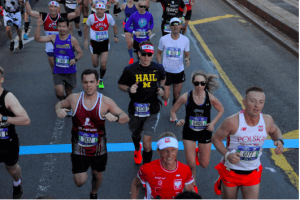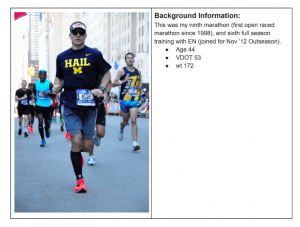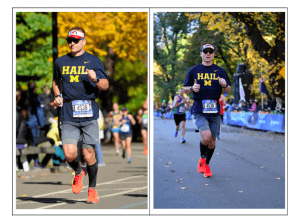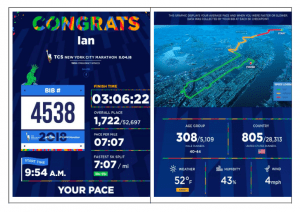The Secret To Endurance Success
When we think of endurance training, we often look at it from a singular viewpoint. Either by race, by season, by a specific goal. But the real reward is viewing endurance training as well, endurance training… aka, the long game. Each race, each season, every success, every failure, the day-to-day, and even the mental toughness of it all, play a part in your lifelong endurance fitness.
One of the most challenging things we find about working with endurance athletes is altering the way they view training. In everything that Endurance Nation does, we challenge the status quo. However, it comes with barriers that are extremely difficult to break through.
The Endurance Nation way includes a Community Coaching Mentality, The OutSeason®, Swim fitness, race execution, Run Durability, zones, and racing with power. The outside world trains you and your brain for these activities can seem like a quick fix, or a one goal at a time mentality. But, what if the goal is a collective lifetime of an endurance journey?
Many times we’ve highlighted athlete Ian Kurth. Years ago when he joined the team, he trusted Endurance Nation, the process and the contribution he would bring to the team. Over the years we have found that athletes that believe the process and open their minds to retrain their brain are the athletes that have the highest successes within the team. They also are the athletes that end up contributing the most. They take what they learn, and they add their perspective, their trials and collectively make the team stronger. This approach is the heart of what EN is all about!
So, let’s dive into a run journey that started over a decade ago and through Endurance Nation, ended with Ian Kurth racing a bucket list race of his– The New York City Marathon and a cherry on top of a Boston Qualifying time.
Background:
The NYC Marathon has been on my bucket list for quite some time. Back in the day, I use to run marathons quite a bit… Disney, Chicago, Barcelona, San Diego, Toronto, Raleigh, etc. NYC seemed to always be in the discussion for the next race, but as time marched on, I realized that NYC had been shelved in the “maybe someday” status for too long.
It is impressive how long “someday status” can be… Post-grad training, moves, starting a family, new job, and life put on hold any competitive aspirations for about a decade. Then came my Ironman phase where racing marathons were not only discouraged but required. Ultimately, for a period of close to 20 years, not only has running the NYC marathon, but aspirations of qualifying for the Boston Marathon have been rattling around in my head, germinating in my subconscious.
Preparation:
After a string of eight Ironmans® over five seasons, for a variety of personal and professional reasons, I decided to defer IMWI until 2019 and stand down from triathlon for a season. This break brought some much-needed bandwidth for family activities and mental downtime and allowed me to swim and bike only when it interested me without structure. The key to this plotline is that I continued to run continuously, every day. Currently, this manifests as more than 400 days straight and close to 1,000 days with only a smattering of 20 total days off. Throughout this foundation, I have been averaging around 45-50 miles per week, and I am on track to complete my third straight year of logging more than 2,000 miles running.
Throughout the years we have peeked into Ian’s training life from his decision to train indoors almost exclusively and a few of his many Ironman® races, most notably, Wisconsin 2016
Opportunity:
This daily training and running consistency proved critical as in early September Endurance Nation served up an opportunity to check off a long-standing adventure from my bucket list, with a slot to run NYC. The opportunity wouldn’t have happened without all that Endurance Nation is and their Tri Club standing, and because of that, I’m honored to be apart of the EN family.
Upon reflection, this invitation and opportunity couldn’t have come at a better time. I had a strong base of running, I had a pent-up competitive itch to race, I had the time available to bring my family to NYC, I aged up in the BQ criteria, and I had time to put in the proper training build.
Training:
400+ days of a run streak served as my base. I dropped into the EN advanced marathon plan as soon as I registered, about eight weeks before the event. One of the pleasures of the EN run durability program is that it facilitates lots of smooth, consistent running.
The double-edged sword to this comfortable routine is that I haven’t run “fast” in over a year. Entering the training cycle, I quickly got re-acquainted with my old friends, aka Z4Z5 intervals, tempo pacing, hill work and variably paced long runs. Desperate all of this accumulated mileage, I hadn’t done any proper long runs beyond 14 miles in about three seasons. Previewing the scheduled pace work combined with long runs was somewhat daunting prospect as this was my first exposure to “fast” and “at pace” running in a long time. In the past, I have had high aspirations to follow such a plan, but had repeatedly failed in completing the prescribed work. However, as validation to the base work, as well as a confidence builder, this was the first time I completed every workout as written plus additional easy runs on schedule “off days” to keep the run streak alive.
I trained primarily by RPE/pace, HR secondarily, and observed power retrospectively via Stryd. That said, I felt my long run data points were too sparse to be deemed reliable for confident race planning. This lead to quite a bit of uncertainty for setting a race pace strategy. Prior race data always helps, but as I hadn’t run an open marathon in a decade, the most similar metric came from HM races and the last being 2016.
The main take away to this type of training is to note the patience it takes to dial back. Endurance athletes are programmed to think that singular long workouts are what make a strong endurance athlete, rather than seeing the endurance of long periods of smaller daily work. The endurance is in the discipline, the base, the cumulative growth, not how long your “long run” was in any particular one week.
Race Plan:
In some way, being unshackled from quality guiding metrics was liberating. Not having “raced” a marathon in many years was also a reprieve. I was not boxed in by metrics from past race performances or even recent key workout pacing. This allowed me to instead to race by feel without expectation.
Ultimately, I established simple priorities to execute towards:
-
Get to the start healthy.
-
Race with humility yet confidence, and enjoy the event experience
-
Execute a Boston Qualifying time of 3:20 (7:22mi)
-
Target a safe Boston Qualifying time which I established as 3:15
-
Let it rip and see what happens
Race Day:
Logistically, NYC marathon is an impressive process. My day started by catching a bus from NYC library in midtown Manhattan at 530am. After about an hour long bus commute, we arrived at the starting village on Staten Island. After clearing security checks, participants were then separated into three communities where we waited another 2.5 hours until we were allowed to enter the starting corrals. There was three starting time broken into waves based on predicted finish. I was fortunate in that my start was with the early group, at 950am. Despite being near the front of the 52000 participants, the majority of my run was very congested. There are plenty of blogs that detail this process as well as details of the course — this nice one sent to me by a fellow ENer Ed Eovino
Starting the day, I recognized the conditions offered an “opportunity” for a good day. Sunny, light winds, low humidity, cool, good nights sleep, good taper, appreciation for the opportunity to race, all combined with the novelty and uncertainty of a new distanced proved to be a refreshing and opportunistic racing context. I am thankful that I was able to convert on these conditions. I have raced enough to know that despite perfect execution and control of pre-race variables, leading into an event, the day can serve up unexpected challenged. — so much so that in some cases you can convince yourself that things are sideways before the gun goes off. I recognized that this wasn’t the case, I was grateful and eager for the opportunity to capitalize.
My strategy from the framework of my established pre-race priorities ultimately morphed conceptually into racing comfortably, but sustainably hard for the first 16 miles with a 155HR cap. Beyond 16 miles, I knew from experience that I could suffer for an hour, and if I could get to around mile 16 feeling reasonable, I permitted myself to dial up the effort gradually. One of the many learning points from my IMWI 2017 beatdown was that definitely pushed my suffer quotient deep into the red, and in return, I received a better understanding o how deep my well descends.
When compared to that IM experience, a 3-hour run that includes an hour difficulty pales in comparison to the crucible of an 11 hour day with close to four hours of misery. Not to discount the achievement of running a marathon, but approaching this race through this lens established a perspective that helped to manage the last difficult miles better.
Realistically, I felt 7:20’s would be reasonable, achievable, sustainable, and yet challenging enough. As the first 6 miles or so played out, I kept noticing the 3:10 (7:14mi) pacing group nearby. I tucked into this group for the next 6 miles or so and then eventually felt strong enough to move past them thinking I might “bank” a bit of time while feeling good. When we crossed the 59th street bridge into Manhattan at mile 16 and headed into thunder alley on 1st ave, I permitted myself to begin ramping it up. I broke the remaining miles into landmark sections: mile 20, reentering manhattan, entering Central Park and the finishing mile. Knowing each step is closer to the finish, I kept pushing a bit harder, and committing to doing whatever possible to maintain the pace. Reflecting, I hit these transition well — Hr increase, pace increase, power increase, RPE increase. This in itself was satisfying. Achieving a time result that was about 10 minutes faster than a pre-race stretch goal was also very satisfying and frankly one I have yet to absorb. When running in my twenties, I always had this “7:07 brings you in a 3:07” mantra in my head. In my ignorant youth, however, I had no idea how much hopium this contained as at the time my fitness and experience to execute this type of pace was nowhere close to that zip code. Now in my mid-forties, to unexpectedly accomplish holding this pace while negative splitting was pretty fun.
Reflections:
Several people have asked what I did to achieve this result. In reality, my preparation for this race was extremely simple. Lots of consistent, easy running, day in and day out. This approach is remarkably straightforward and very effective, but it is not easy.
I know of no sustainable shortcuts. That said, this approach is congruent with my personality and dovetails into how I have found success in achieving goals in other areas of my life. Distilled, when working towards a goal, I make conscientious efforts to apply strategic discipline in an effort to establish good habits until they become routine. When discipline is applied correctly, “hard stuff becomes habit and habit makes hard stuff easy” in the case of running, several seasons back, I committed to a 30 day run challenge. I then committed to 25 miles per week minimum for a year. Then I challenged myself to the full ass run challenge.
Then I decided to run the year 2016 in miles within my run streak.
Then I decided to do this again in 2017
……and again 2018.
Over the years, I have found much inspiration from my teammates at EN who are on similar journeys. My favorite race reports are those who describe their breakthrough performances achieving “overnight success” on the podium but somehow weave into their story the YEARS of consistent toil, disappointments, and setbacks. Their perspective reveals how this work and occasional disappointment forged a determination to seize their opportunity that presented on their day. Their gratitude for who they have become through this process is inspiring.
Some may be disappointed in this response, as I can offer no secret hack or advanced training prescription to fast track results. Hopefully, though there is a growing silent majority of you out there who find some inspiration and validation to their own journey. I believe that clarity comes with recognizing that it is the road/the path/the journey that is the true treasure and is in itself a blessing.
So, if you’ve lasted this long (because even learning about endurance takes endurance!) let’s recap:
Key Take-A-Ways
- Commit to the process of an endurance lifestyle
- Remind yourself constantly that you’re playing the long game
- There is no quick fix
- Grow your mental toughness muscle along the way
- Learn and lean on teammates, coaches and your community
- Take time to read and learn up on race reports, athlete posts, etc, knowledge is power!
- Pay it forward, the only way we grow this sport is to add to the collective.
- Get comfortable with the uncomfortable
- Be consistent
- Enjoy the process!
“What you get by achieving your goals is not as important as what you become when achieving your goals”







Leave a Reply